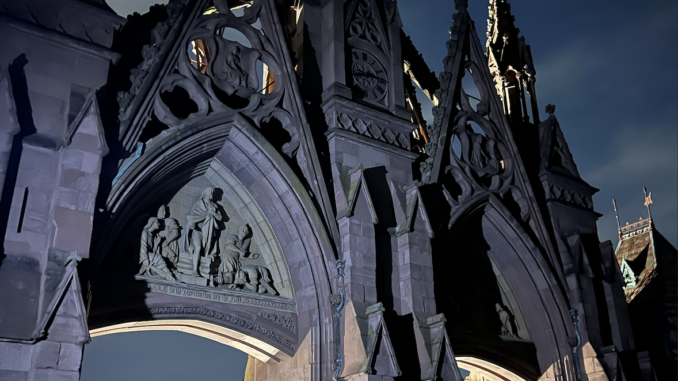
By ANGELINA BANEK
On Tuesday Sept. 24th the Green-Wood Cemetery held an event called Memorializing Ecological Loss. This event was a part of Climate Week, which will encompass over 600 events and activities across New York City this year. In a busy week filled with major events with topics ranging from climate change to food insecurity, this evening at Green-Wood was an opportunity for people to step back and process their own experiences with environmental loss.
The setting in Green-Wood’s Modern Chapel was intimitate. Six rows of red rounded couches seated about 30 people who came to participate. For close to half, it was their first time visiting Green-Wood. When one panel member teared up discussing personal experiences with loss, strangers in the audience passed up tissues.
Panelist Johanna Lovecchio, a Columbia University Climate School professor, shared her revelations from this year’s Climate Week, which she described as a “sensory overload.” Just that morning, she had attended another panel, which focused on minerals used for production.
While exploring Green-Wood, a National Historic Landmark with over 470 acres of land, she learned that during World War II families with large plots encircled by metal and stone sacrificed these valuable metal fixtures for the war effort.
“It struck me as a really really different social mindset, that people In World War II were so organized around their commitment to a broader social good, which in their mind was a war effort, that they would give something as important as the thing that encapsulated a family in grief to that public effort,” Lovecchio said. “It made me think, like, what would it take for us, after having sat through this critical minerals thing this morning, what would it take for us to say ‘take my phone.’”
It is not a surprise that the historic cemetery brought up new perspectives like this within climate-concerned individuals. The Green-Wood Cemetery is a place where nearly 570,000 people are remembered and laid to rest. On Sep. 24th, it was a place to reflect on other types of losses.
Also on the panel was Dr. Maya Livio, an Assistant Professor of Climate, Environmental Justice, and Media and Communication at American University. She talked about the importance of recognizing loss and how it can be used as a catalyst for climate action.
“Something I’ve learned through my own grief practice is that legacy, thinking about legacy for me, shifts grief from a kind of paused state to a more active state,” said Dr. Livio. “If we’re thinking about memorizing loss, how can we think about the legacy that is lost, and use that as a sort of mobilizer, and use that as a legacy that’s not just a statue, but actually drives us towards action.”
Something another panelist, Katie Coyne, said really honed in on the importance of facilitating these conversations as a part of environmental justice work during a time like Climate Week.
“If we don’t acknowledge trauma, we can’t do restorative work, and if we can’t talk about intergenerational climate trauma, it’s not good enough,” Conye said.
After the panel concluded, the event transitioned into a more interactive discussion activity. Guests were divided into four groups and escorted to tables. These tables were covered in paper, and participants were asked to draw and discuss how they’ve experienced ecological loss and how this loss could be memorialized.
Rebeca Zaglul, a Brooklyn resident, shared her own experience with seeing changes in The Dominican Republic as new luxury hotels go up. She found the activity to be eye opening.
“I really enjoyed getting together and talking about experiences and the places we’ve lost, and the connection between loss and space. I didn’t think about it before and realized I have experienced it,” Zaglul said.
